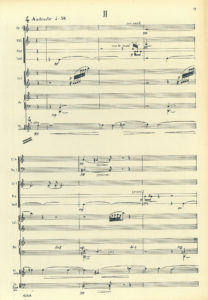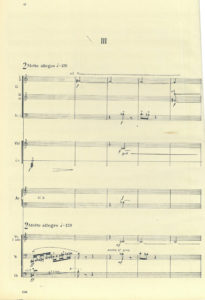- Viola Concerto, PWM score, mov. 1
- Viola Concerto, PWM score, mov. 2
- Viola Concerto, PWM score, mov. 3
Issue 7 of Ruch Muzyczny from 1975 featured an interview conducted by Krzysztof Lisicki with the eminent Polish viola player Stefan Kamasa. In it the artist revealed the inside story of the creation of Grażyna Bacewicz’s Concerto for viola and orchestra:
The idea of asking a Polish composer to write a work for viola was something I had been considering since 1953. […] With the exception of Tansman’s single Concerto for viola and orchestra, a minor piece by Wieniaswki and Witold Rudziński’s Sonata, there were no other viola pieces at the time. Yet the world viola literature is vast and even full of masterpieces […] I kept asking myself: Who among Polish composers would undertake to write a concerto for viola and orchestra? Around 1961 I asked Grażyna Bacewicz to do it. The composer approached my request, or, to be more precise, my suggestion, very seriously. But she was working on other commissions at the time. […] I received the manuscript of movements I and II for Christmas 1967. With great curiosity and joy – after all, it was a result of my initiative in a way – I explored every bar of this music. In March 1968 I received movement III. I was so engrossed in this music in the following years that I did not notice when I learned my part by heart. This made the news of Grażyna Bacewicz’s death all the more painful for me.
The concerto was written at a time when the composer’s oeuvre was dominated by the sonoristic technique. The factor shaping the form of the piece, its dramaturgy was the texture, its various forms, degree of differentiation and changeability. The composer’s last concerto for a solo instrument with orchestra is thus marked by a radicalisation of the means used in her previous works of the genre: Cello Concerto No. 2 and Violin Concerto No. 7. This consists in abandoning the shaping of the form as a process, development of some threads in favour of a “montage form” (Maryla Renat, “Wybrane zagadnienia idiomu kompozytorskiego Grażyny Bacewicz”, Częstochowa 2005, p. 71). The most vivid example of such an approach to the problem of the form is the first movement – Moderato. Allegro. The striking element in it is the concise nature of new musical ideas appearing again and again, a lack of epic panache which still characterised Violin Concerto No. 7 written in 1965. The viola part, although not lacking short cantilenas (one of them is a reminder, in no. 4, of the Intermezzo theme from Partita, but a second up – from F5 sharp, another – the initial “gesture” from the Prelude from that same Partita), is dominated by various ostinatos, chordal runs, figurations in the form of the composer’s favourite passages consisting in chromatic shifts of a selected sound cell, usually composed of three notes (for example, third bar after no. 6) as well as fingering passages consisting in transposing a selected cell by a fifth, which in practice means “performing the entire passage in the same position, with just a change of strings” (Maryla Renat, p. 61). This type of form is also characteristic of the violin part in the orchestra, and all instruments – both the viola and the orchestral ensemble – have their articulation constantly changed, which enriches the sound colour of the piece. The orchestral part, despite its full line-up with an expanded percussion, has an openwork form. Tuttis, as well as full instrumental groups, appear rarely, with the solo instrument usually being accompanied by two or three sound lines. Despite the absence of old formal patterns, a mini-cadenza of sorts appears in the viola part towards the end of the first movement (no. 19), while the final tremolo of the viola and cymbal against a background of arrhythmically repeated chords of other instruments can be regarded as an element complementing the movement in its arch form.
The second movement (Andante) begins in the solo instrument with the first sentence of the Intermezzo from Partita, emphasising the final “lydianism”. What follows is a double game of self-quotations: the viola line in the next three bars develops according to a pattern borrowed from the middle part (Andantino melancolico) of the Trio for oboe, harp and percussion, which, too, is based on the beginning of the Intermezzo from Partita. What draws our attention in the middle fragment are dialogues of the viola with the harp, oboe, flute and other instruments, ending with a tempestuous accelerando, followed by a return, in an A1 form, of the Intermezzo theme.
The third movement (Molto allegro) opens with a “demonic” orchestral introduction, filling the sound space with short ostinatos, tremolos and glissandos, preparing the entry of the viola, which, after a short passage, begins a strange dance, a kind of “hocket oberek” in 6/8, played in dyads come percussione, then also au talon, which enhances the dryness of the sound. Cantilena and figuration episodes come and go suddenly, serving as reminiscences, if we treat this movements as a distant echo of the sonata rondo with a long viola cadenza towards the end and short intervention of the tambourine and bongos in the middle. Each appearance of the “hocket oberek” is accompanied by selected instruments complementing the colour palette. The most extraordinary sound is achieved by the composer, when the “oberek” theme (gettato, come percussione) is accompanied in the first beat of each bar by dense chords of the celesta and harp (no. 8).
The lively, virtuosic third movement of the concerto differs slightly in its mood from the previous two movements, with their dominant tone of nostalgia, occasionally brutally silenced by dramatically highly charged fragments. This nostalgic tone most likely has its source in the unique sound of the viola – warm, but more subdued than the bright colour of the violin. The reminiscence-like nature of some fragments may have been influenced by other circumstances as well. What circumstances? We will never know.
Dedicated to Stefan Kamasa, the Concerto for viola and orchestra was performed for the first time after the composer’s death, on 20 June 1969. The soloist, Stefan Kamasa, was accompanied by the Warsaw Philharmonic Orchestra conducted by Witold Rowicki.


